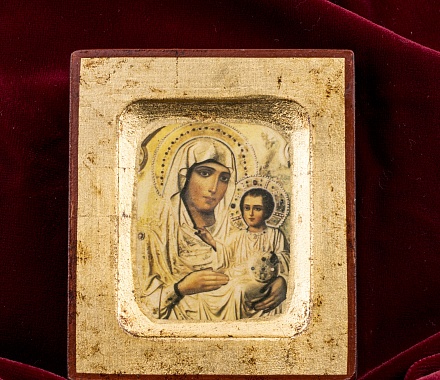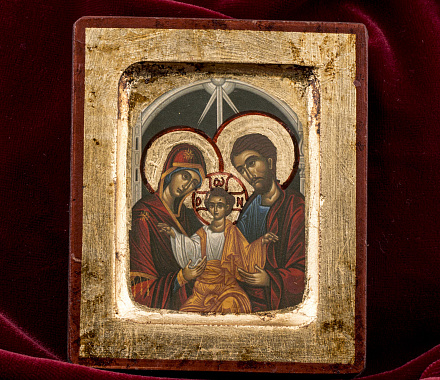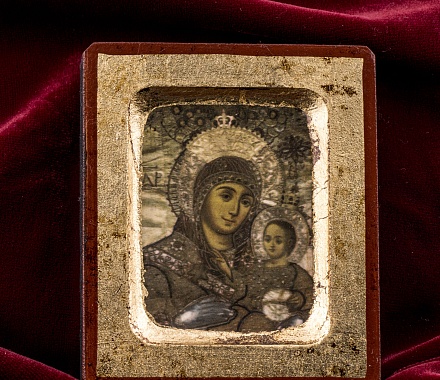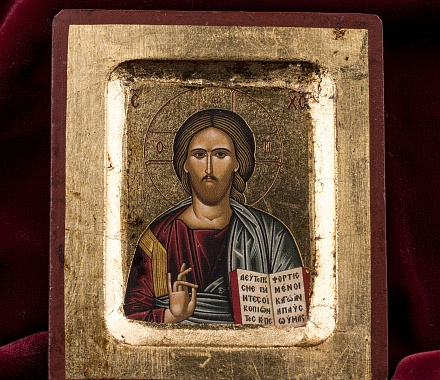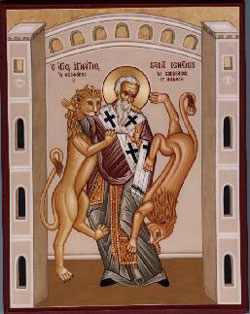
Feastday: October 17"I prefer death in Christ Jesus to power over the farthest limits of the earth. He who died in place of us is the one object of my quest. He who rose for our sakes is my one desire."
In 107, during the reign of the brutal Emperor Trajan, this holy Bishop was wrongfully sentenced to death because he refused to renounce the Christian faith. He was taken under guard to Rome where he was to be brutally devoured by wild beasts in a public spectacle.
CHESAPEAKE, Va. (Catholic Online) - The second Bishop of Antioch, Syria, this disciple of the beloved Disciple John was consecrated Bishop around the year 69 by the Apostle Peter, the first Pope. A holy man who was deeply loved by the Christian faithful, he always made it his special care to defend "orthodoxy" (right teaching) and "orthopraxy" (right practice) among the early Christians.
In 107, during the reign of the brutal Emperor Trajan, this holy Bishop was wrongfully sentenced to death because he refused to renounce the Christian faith. He was taken under guard to Rome where he was to be brutally devoured by wild beasts in a public spectacle. During his journey, his travels took him through Asia Minor and Greece. He made good use of the time by writing seven letters of encouragement, instruction and inspiration to the Christians in those communities. We still have these letters as a great treasure of the Church today.
The content of the letters addressed the hierarchy and structure of the Church as well as the content of the orthodox Christian faith. It was Bishop Ignatius who first used the term "catholic" to describe the whole Church. These letters connect us to the early Church and the unbroken, clear teaching of the Apostles which was given to them directly by Jesus Christ. They also reveal the holiness of a man of God who became himself a living letter of Christ. The shedding his blood in the witness of holy martyrdom was the culmination of a life lived conformed to Jesus Christ. Ignatius sought to offer himself, in Christ, for the sake of the Church which he loved. His holy martyrdom occurred in the year 107.
In his pastoral letters he regularly thanked his brother and sister Christians for their concern for his well being but insisted on following through in his final witness of fidelity: "I know what is to my advantage. At last I am becomŹing his disciple. May nothing entice me till I happily make my way to Jesus Christ! Fire, cross, struggles with wild beasts, wrenching of bones, mangling of limbs-let them come to me, provided only I make my way to Jesus Christ. I would rather die and come to Jesus Christ than be king over the entire earth. Him I seek who died for us; him I love who rose again because of us."
Bishop Ignatius was not afraid of death. He knew that it had been defeated by the Master. He followed the Lord Jesus into his Passion, knowing that he would rise with Him in his Resurrection. He wrote to the disciples in Rome: "Permit me to imitate my suffering God ... I am God's wheat and I shall be ground by the teeth of beasts, that I may become the pure bread of Christ." The beauty of this Eucharistic symbolism in these words reflects the deep theology of a mystic. He was dedicated to defending the true teaching handed down by the Apostles so that the brothers and sisters in the early Christian communities, and we who stand on their shoulders, would never be led astray by false teaching. He urged them to always listen to their Bishops because they were the successors of the Apostles. He died a Martyrs death in Rome, devoured by two lions in one of the cruel demonstrations of Roman excess and animosity toward the true faith. Anticipating this event he wrote these inspired words:
A letter to the Romans by St Ignatius of Antioch
"I am God's wheat and shall be ground by the teeth of wild animals. I am writing to all the churches to let it be known that I will gladly die for God if only you do not stand in my way. I plead with you: show me no untimely kindness. Let me be food for the wild beasts, for they are my way to God. I am God's wheat and shall be ground by their teeth so that I may become Christ's pure bread. Pray to Christ for me that the animals will be the means of making me a sacrificial victim for God. No earthly pleasures, no kingdoms of this world can benefit me in any way. I prefer death in Christ Jesus to power over the farthest limits of the earth. He who died in place of us is the one object of my quest. He who rose for our sakes is my one desire.
The time for my birth is close at hand. Forgive me, my brothers. Do not stand in the way of my birth to real life; do not wish me stillborn. My desire is to belong to God. Do not, then, hand me back to the world. Do not try to tempt me with material things. Let me attain pure light. Only on my arrival there can I be fully a human being. Give me the privilege of imitating the passion of my God. If you have him in your heart, you will understand what I wish. You will sympathize with me because you will know what urges me on.
The prince of this world is determined to lay hold of me and to undermine my will which is intent on God. Let none of you here help him; instead show yourselves on my side, which is also God's side. Do not talk about Jesus Christ as long as you love this world. Do not harbor envious thoughts. And supposing I should see you, if then I should beg you to intervene on my behalf, do not believe what I say. Believe instead what I am now writing to you. For though I am alive as I write to you - still - my real desire is to die. My love of this life has been crucified, and there is no yearning in me for any earthly thing. Rather within me is the living water which says deep inside me: "Come to the Father." I no longer take pleasure in perishable food or in the delights of this world. I want only God's bread, which is the flesh of Jesus Christ, formed of the seed of David, and for drink I crave his blood, which is love that cannot perish.
I am no longer willing to live a merely human life, and you can bring about my wish if you will. Please, then, do me this favour, so that you in turn may meet with equal kindness. Put briefly, this is my request: believe what I am saying to you. Jesus Christ himself will make it clear to you that I am saying the truth. Only truth can come from that mouth by which the Father has truly spoken. Pray for me that I may obtain my desire. I have not written to you as a mere man would, but as one who knows the mind of God. If I am condemned to suffer, I will take it that you wish me well. If my case is postponed, I can only think that you wish me harm."
To all our readers, Please don't scroll past this.
Today, we humbly ask you to defend Catholic Online's independence. 98% of our readers don't give; they simply look the other way. If you donate just $5.00, or whatever you can, Catholic Online could keep thriving for years. Most people donate because Catholic Online is useful. If Catholic Online has given you $5.00 worth of knowledge this year, take a minute to donate. Show the volunteers who bring you reliable, Catholic information that their work matters. If you are one of our rare donors, you have our gratitude and we warmly thank you. Help Now > Late 1st / early 2nd century Christian writer and Patriarch of AntiochIgnatius of Antioch (/ɪɡˈneɪʃəs/; Greek: Ἰγνάτιος Ἀντιοχείας, Ignátios Antiokheías; died c. 108/140 AD), also known as Ignatius Theophorus (Ἰγνάτιος ὁ Θεοφόρος, Ignátios ho Theophóros, lit. "the God-bearing"), was an early Christian writer and bishop of Antioch. While en route to Rome, where he met his martyrdom, Ignatius wrote a series of letters. This correspondence now forms a central part of a later collection of works known to be authored by the Apostolic Fathers. He is considered to be one of the three most important of these, together with Clement of Rome and Polycarp. His letters also serve as an example of early Christian theology. Important topics they address include ecclesiology, the sacraments, and the role of bishops.
Life
| Part of a series of articles on |
| Ignatius of Antioch |
|---|
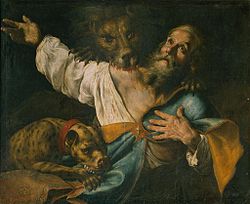 |
| Main article |
| Ignatius of Antioch |
| Epistles of Ignatius |
|
Epistle to the Ephesians |
| Related epistles |
| Epistle of Polycarp to the Philippians |
|
Nothing is known of Ignatius' life apart from what may be inferred internally from his letters, except from later (sometimes spurious) traditions. It is said Ignatius converted to Christianity at a young age. Tradition identifies Ignatius, along with his friend Polycarp, as disciples of John the Apostle. Later in his life, Ignatius was chosen to serve as Bishop of Antioch; the fourth-century Church historian Eusebius writes that Ignatius succeeded Evodius. Theodoret of Cyrrhus claimed that St. Peter himself left directions that Ignatius be appointed to the episcopal see of Antioch. Ignatius called himself Theophorus (God Bearer). A tradition arose that he was one of the children whom Jesus Christ took in his arms and blessed.
Veneration
Ignatius' feast day was kept in his own Antioch on 17 October, the day on which he is now celebrated in the Catholic Church and generally in western Christianity, although from the 12th century until 1969 it was put at 1 February in the General Roman Calendar.
In the Eastern Orthodox Church it is observed on 20 December. The Synaxarium of the Coptic Orthodox Church of Alexandria places it on the 24th of the Coptic Month of Koiak (which is also the 24 day of the fourth month of Tahisas in the Synaxarium of The Ethiopian Orthodox Tewahedo Church), corresponding in three years out of every four to 20 December in the Julian Calendar, which currently falls on 2 January of the Gregorian Calendar.
Ignatius is remembered in the Church of England with a Lesser Festival on 17 October.
Martyrdom
Circumstances of martyrdom
Instead of being executed in his home town of Antioch, Ignatius was escorted to Rome by a company of ten Roman soldiers:
From Syria even unto Rome I fight with beasts, both by land and sea, both by night and day, being bound to ten leopards, I mean a band of soldiers...
— Ignatius to the Romans Chapter 5
Scholars consider Ignatius' transport to Rome unusual, since those persecuted as Christians would be expected to be punished locally. Stevan Davies has pointed out that "no other examples exist from the Flavian age of any prisoners except citizens or prisoners of war being brought to Rome for execution."
If Ignatius were a Roman citizen, he could have appealed to the emperor, but then he would usually have been beheaded rather than tortured. Furthermore, the epistles of Ignatius state that he was put in chains during the journey to Rome, but it was illegal under Roman law for a citizen to be put in bonds during an appeal to the emperor.
Allen Brent argues that Ignatius was transferred to Rome at the request of the emperor in order to provide entertainment to the masses by being killed in the Colosseum. Brent insists, contrary to some, that "it was normal practice to transport condemned criminals from the provinces in order to offer spectator sport in the Colosseum at Rome."
Stevan Davies rejects the idea that Ignatius was transported to Rome for the games at the Colosseum. He reasons that "if Ignatius was in some way a donation by the Imperial Governor of Syria to the games at Rome, a single prisoner seems a rather miserly gift." Instead, Davies proposes that Ignatius may have been indicted by a legate, or representative, of the governor of Syria while the governor was away temporarily, and sent to Rome for trial and execution. Under Roman law, only the governor of a province or the emperor himself could impose capital punishment, so the legate would have faced the choice of imprisoning Ignatius in Antioch or sending him to Rome. Davies postulates that the legate may have decided to send Ignatius to Rome so as to minimize any further dissension among the Antiochene Christians.
Christine Trevett has called Davies' suggestion "entirely hypothetical" and concludes that no fully satisfactory solution to the problem can be found, writing, "I tend to take the bishop at his word when he says he is a condemned man. But the question remains, why is he going to Rome? The truth is that we do not know."
Route of travel to Rome
During the journey to Rome, Ignatius and his entourage of soldiers made a number of lengthy stops in Asia Minor, deviating from the most direct land route from Antioch to Rome. Scholars generally agree on the following reconstruction of Ignatius' route of travel:
- Ignatius first traveled from Antioch, in the province of Syria, to Asia Minor. It is uncertain whether he traveled by sea or by land.
- He was then taken to Smyrna, via a route that bypassed the cities of Magnesia, Tralles, and Ephesus, but likely passed through Philadelphia (cf. Ign. Phil. 7).
- Ignatius then traveled to Troas, where he boarded a ship bound for Neapolis in Macedonia (cf. Ign. Pol. 8).
- He then passed through the city of Philippi (cf. Pol. Phil. 9).
- After this, he took some land or sea route to Rome.
During the journey, the soldiers seem to have allowed Ignatius to meet with entire congregations of Christians while in chains, at least while he was in Philadelphia (cf. Ign. Phil. 7), and numerous Christian visitors and messengers were allowed to meet with him on a one-on-one basis. These messengers allowed Ignatius to send six letters to nearby churches, and one to Polycarp, the bishop of Smyrna.
These aspects of Ignatius' martyrdom are also regarded by scholars as unusual. It is generally expected that a prisoner would be transported on the most direct, cost-effective route to their destination. Since travel by land in the Roman Empire was between five and fifty-two times more expensive than travel by sea, and Antioch was a major port city, the most efficient route would likely have been entirely by sea. Steven Davies argues that Ignatius' circuitous route to Rome can only be explained by positing that he was not the main purpose of the soldiers' trip, and that the various stops in Asia Minor were for other state business. He suggests that such a scenario would also explain the relative freedom that Ignatius was given to meet with other Christians during the journey.
Date of martyrdom
Due to the sparse and fragmentary nature of the documentation of Ignatius' life and martyrdom, the date of his death is subject to a significant amount of uncertainty. Tradition places the martyrdom of Ignatius in the reign of Trajan, who was emperor of Rome from 98 to 117 AD. But the earliest source for this Trajanic date is the 4th century church historian Eusebius of Caesarea, who is regarded by some modern scholars as an unreliable source for chronological information regarding the early church. Eusebius had an ideological interest in dating church leaders as early as possible, and ensuring that there were no gaps in succession between the original apostles of Jesus and the leaders of the church in his day.
While many scholars accept the traditional dating of Ignatius' martyrdom under Trajan, others have argued for a somewhat later date. Richard Pervo dated Ignatius' death to 135-140 AD. British classicist Timothy Barnes has argued for a date in the 140s AD, on the grounds that Ignatius seems to have quoted a work of the Gnostic Ptolemy in one of his epistles, who only became active in the 130s.
Death and aftermath
Ignatius himself wrote that he would be thrown to the beasts, and in the fourth century Eusebius reports tradition that this came to pass, which is then repeated by Jerome who is the first to explicitly mention "lions." John Chrysostom is the first to allude to the Colosseum as the place of Ignatius' martyrdom. Contemporary scholars are uncertain that any of these authors had sources other than Ignatius' own writings.
According to a medieval Christian text titled Martyrium Ignatii, Ignatius' remains were carried back to Antioch by his companions after his martyrdom. The sixth-century writings of Evagrius Scholasticus state that the reputed remains of Ignatius were moved by the Emperor Theodosius II to the Tychaeum, or Temple of Tyche, which had been converted into a church dedicated to Ignatius. In 637 the relics were transferred to the Basilica di San Clemente in Rome.
The Martyrium Ignatii
There is a purported eye-witness account of his martyrdom, named the Martyrium Ignatii. It is presented as being an eye-witness account for the church of Antioch, attributed to Ignatius' companions, Philo of Cilicia, deacon at Tarsus, and Rheus Agathopus, a Syrian.
Its most reliable manuscript is the 10th-century Codex Colbertinus (Paris), in which the Martyrium closes the collection. The Martyrium presents the confrontation of the bishop Ignatius with Trajan at Antioch, a familiar trope of Acta of the martyrs, and many details of the long, partly overland voyage to Rome. The Synaxarium of the Coptic Orthodox Church of Alexandria says that he was thrown to the wild beasts that devoured him and rent him to pieces.
Epistles
 Painting of Ignatius of Antioch from the Menologion of Basil II (c. 1000 AD)
Painting of Ignatius of Antioch from the Menologion of Basil II (c. 1000 AD)
The following seven epistles preserved under the name of Ignatius are generally considered authentic, since they were mentioned by the historian Eusebius in the first half of the fourth century.
Seven original epistles:
- The Epistle to the Ephesians,
- The Epistle to the Magnesians,
- The Epistle to the Trallians,
- The Epistle to the Romans,
- The Epistle to the Philadelphians,
- The Epistle to the Smyrnaeans,
- The Epistle to Polycarp, a bishop of Smyrna.
Recensions
The text of these epistles is known in three different recensions, or editions: the Short Recension, found in a Syriac manuscript; the Middle Recension, found only in Greek manuscripts; and the Long Recension, found in Greek and Latin manuscripts.
For some time, it was believed that the Long Recension was the only extant version of the Ignatian epistles, but around 1628 a Latin translation of the Middle Recension was discovered by Archbishop James Ussher, who published it in 1646. For around a quarter of a century after this, it was debated which recension represented the original text of the epistles. But ever since John Pearson's strong defense of the authenticity of the Middle Recension in the late 17th century, there has been a scholarly consensus that the Middle Recension is the original version of the text. The Long Recension is the product of a fourth-century Arian Christian, who interpolated the Middle Recension epistles in order posthumously to enlist Ignatius as an unwitting witness in theological disputes of that age. This individual also forged the six spurious epistles attributed to Ignatius (see § Pseudo-Ignatius below).
Manuscripts representing the Short Recension of the Ignatian epistles were discovered and published by William Cureton in the mid-19th century. For a brief period, there was a scholarly debate on the question of whether the Short Recension was earlier and more original than the Middle Recension. But by the end of the 19th century, Theodor Zahn and J. B. Lightfoot had established a scholarly consensus that the Short Recension is merely a summary of the text of the Middle Recension, and was therefore composed later.
Authenticity
Ever since the Protestant Reformation in the 16th century, the authenticity of all the Ignatian epistles has come under intense scrutiny. John Calvin called the epistles "rubbish published under Ignatius’ name." Some Protestants have tended to want to deny the authenticity of all the epistles attributed to Ignatius because they seem to attest to the existence of a monarchical episcopate in the second century. The Roman Catholic Church has long held up the authenticity of the letters from past to present.
In 1886, Presbyterian minister and church historian William Dool Killen published an essay extensively arguing that none of the epistles attributed to Ignatius is authentic. Instead, he argued that Callixtus, bishop of Rome, forged the letters around AD 220 to garner support for a monarchical episcopate, modeling the renowned Saint Ignatius after his own life to give precedent for his own authority. Killen contrasted this episcopal polity with the presbyterian polity in the writings of Polycarp.
Some doubts about the authenticity of the original letters continued into the 20th century. In the late 1970s and 1980s, the scholars Robert Joly, Reinhard Hübner, Markus Vinzent, and Thomas Lenchner argued forcefully that the epistles of the Middle Recension were forgeries written during the reign of Marcus Aurelius (161-180 AD). Around the same time, the scholar Joseph Ruis-Camps published a study arguing that the Middle Recension letters were pseudepigraphically composed based on an original, smaller, authentic corpus of four letters (Romans, Magnesians, Trallians, and Ephesians). These publications stirred up tremendous, heated controversy in the scholarly community at the time, but today most religious scholars accept the authenticity of the seven original epistles.
The original texts of six of the seven original letters are found in the Codex Mediceo Laurentianus written in Greek in the 11th century (which also contains the pseudepigraphical letters of the Long Recension, except that to the Philippians), while the letter to the Romans is found in the Codex Colbertinus.
Style and structure
Ignatius's letters bear signs of being written in great haste and without a proper plan, such as run-on sentences and an unsystematic succession of thought. Ignatius modelled his writings after those allegedly written by Paul, Peter, and John, and even quoted or paraphrased biblical entries by these apostles' works freely, such as when he quoted 1 Corinthians 1:18, in his letter to the Ephesians:
Let my spirit be counted as nothing for the sake of the cross, which is a stumbling-block to those that do not believe, but to us salvation and life eternal.
— Letter to the Ephesians 18, Roberts and Donaldson translation
Theology
Christology
Ignatius is known to have taught the deity of Christ:
There is one Physician who is possessed both of flesh and spirit; both made and not made; God existing in flesh; true life in death; both of Mary and of God; first passible and then impassible, even Jesus Christ our Lord.
— Letter to the Ephesians, ch. 7, shorter version, Roberts-Donaldson translation
The same section in text of the Long Recension says the following:
But our Physician is the Only true God, the unbegotten and unapproachable, the Lord of all, the Father and Begetter of the only-begotten Son. We have also as a Physician the Lord our God, Jesus the Christ, the only-begotten Son and Word, before time began, but who afterwards became also man, of Mary the virgin. For "the Word was made flesh." Being incorporeal, He was in the body, being impassible, He was in a passible body, being immortal, He was in a mortal body, being life, He became subject to corruption, that He might free our souls from death and corruption, and heal them, and might restore them to health, when they were diseased with ungodliness and wicked lusts.
— Letter to the Ephesians, ch. 7, longer version
He stressed the value of the Eucharist, calling it a "medicine of immortality" (Ignatius to the Ephesians 20:2). The very strong desire for bloody martyrdom in the arena, which Ignatius expresses rather graphically in places, may seem quite odd to the modern reader. An examination of his theology of soteriology shows that he regarded salvation as one being free from the powerful fear of death and thus to bravely face martyrdom.
Ignatius is claimed to be the first known Christian writer to argue in favor of Christianity's replacement of the Sabbath with the Lord's Day:
Be not seduced by strange doctrines nor by antiquated fables, which are profitless. For if even unto this day we live after the manner of Judaism, we avow that we have not received grace. ...If then those who had walked in ancient practices attained unto newness of hope, no longer observing Sabbaths but fashioning their lives after the Lord's day, on which our life also arose through Him ... how shall we be able to live apart from Him?
— Ignatius to the Magnesians 8:1, 9:1-2, Lightfoot translation.
Let us therefore no longer keep the Sabbath after the Jewish manner, and rejoice in days of idleness. ...But let every one of you keep the Sabbath after a spiritual manner, rejoicing in meditation on the law, not in relaxation of the body ... and not eating things prepared the day before, nor using lukewarm drinks, and walking within a prescribed space. ...And after the observance of the Sabbath, let every friend of Christ keep the Lord's day as a festival, the resurrection-day, the queen and chief of all the days [of the week]. Looking forward to this, the prophet declared, "To the end, for the eighth day," on which our life both sprang up again, and the victory over death was obtained in Christ.
— Letter to the Magnesians 9, Roberts and Donaldson translation, p. 189.
Ecclesiology
Ignatius is the earliest known Christian writer to emphasize loyalty to a single bishop in each city (or diocese) who is assisted by both presbyters (priests) and deacons. Earlier writings only mention either bishops or presbyters.
For instance, his writings on bishops, presbyters and deacons:
Take care to do all things in harmony with God, with the bishop presiding in the place of God, and with the presbyters in the place of the council of the apostles, and with the deacons, who are most dear to me, entrusted with the business of Jesus Christ, who was with the Father from the beginning and is at last made manifest.
— Letter to the Magnesians 2, 6:1
He is also responsible for the first known use of the Greek word katholikos (καθολικός), or Catholic, meaning "universal", "complete" and "whole" to describe the Church, writing:
Wherever the bishop appears, there let the people be; as wherever Jesus Christ is, there is the Catholic Church. It is not lawful to baptize or give communion without the consent of the bishop. On the other hand, whatever has his approval is pleasing to God. Thus, whatever is done will be safe and valid.
— Letter to the Smyrnaeans 8, J.R. Willis translation.
Joseph Lightfoot states the word "catholic (καθόλου)" simply means "universal" and can be found not only before and after Ignatius amongst ecclesiastical and classical writers, but centuries before the Christian era. It is from the word katholikos ("according to the whole") that the word catholic comes. When Ignatius wrote the Letter to the Smyrnaeans in about the year 107 and used the word catholic, he used it as if it were a word already in use to describe the Church. This has led many scholars to conclude that the appellation Catholic Church with its ecclesial connotation may have been in use as early as the last quarter of the first century. On the Eucharist, he wrote in his letter to the Smyrnaeans:
Take note of those who hold heterodox opinions on the grace of Jesus Christ which has come to us, and see how contrary their opinions are to the mind of God. ...They abstain from the Eucharist and from prayer because they do not confess that the Eucharist is the flesh of our Savior Jesus Christ, flesh which suffered for our sins and which that Father, in his goodness, raised up again. They who deny the gift of God are perishing in their disputes.
— Letter to the Smyrnaeans 6:2–7:1
In his letter addressed to the Christians of Rome, he entreats to do nothing to prevent his martyrdom.
Parallels with Peregrinus Proteus
Several scholars have noted that there are striking similarities between Ignatius and the Christian-turned-Cynic philosopher Peregrinus Proteus, as described in Lucian's famous satire The Passing of Peregrinus:
- Both Ignatius and Peregrinus show a morbid eagerness to die.
- Both characters are, or have been, Christians.
- Both are imprisoned by Roman authorities.
- Upon the arrest of both prisoners, Christians from all over Asia Minor come to visit them and bring them gifts (cf. Peregr. 12-13).
- Both prisoners sent letters to several Greek cities shortly before their deaths as "testaments, counsels, and laws", appointing "couriers" and "ambassadors" for the purpose.
It is generally believed that these parallels are the result of Lucian intentionally copying traits from Ignatius and applying them to his satire of Peregrinus. If the dependence of Lucian on the Ignatian epistles is accepted, then this places an upper limit on the date of the epistles: around the 160s AD, just before The Passing of Peregrinus was written.
In 1892, Daniel Völter sought to explain the parallels by proposing that the Ignatian epistles were in fact written by Peregrinus, and later edited to conceal their provenance, but this speculative theory has failed to make a significant impact on the academic community.
Pseudo-Ignatius
Epistles attributed to Saint Ignatius but of spurious origin (their author is often called Pseudo-Ignatius in English) include:
- Epistle to the Tarsians;
- Epistle to the Antiochians;
- Epistle to Hero, a Deacon of Antioch;
- Epistle to the Philippians;
- The Epistle of Maria the Proselyte to Ignatius;
- Epistle to Mary at Neapolis, Zarbus;
- First Epistle to St. John;
- Second Epistle to St. John;
- The Epistle of Ignatius to the Virgin Mary.
